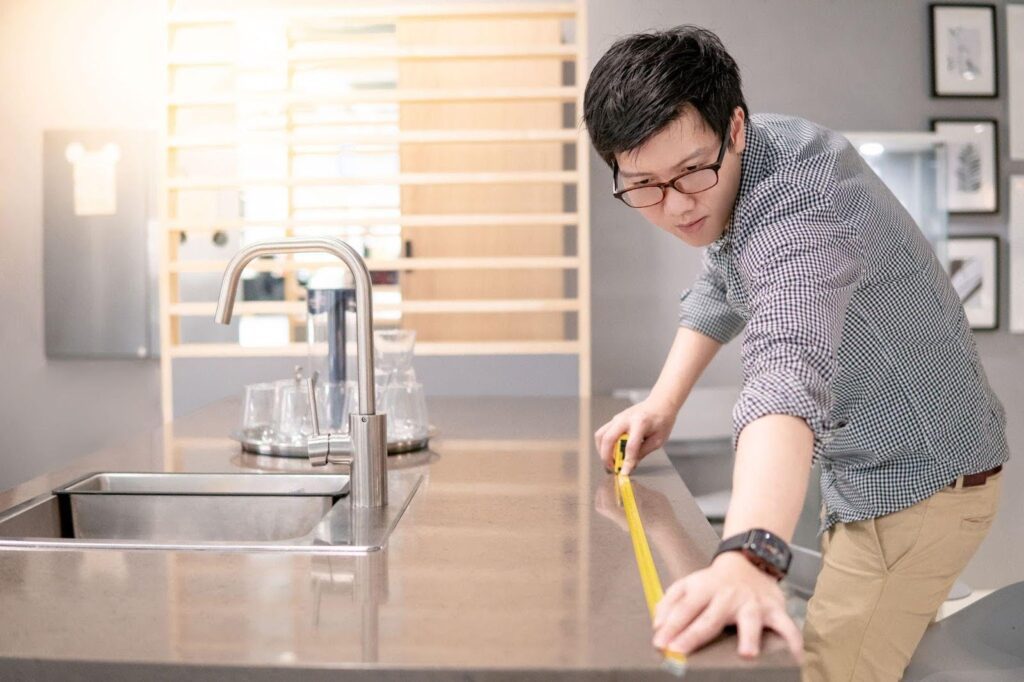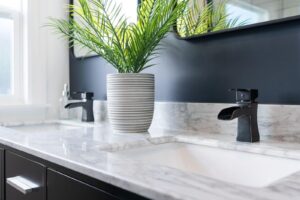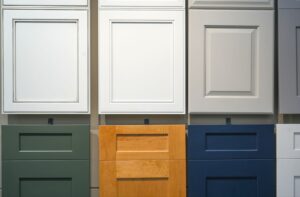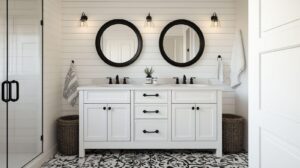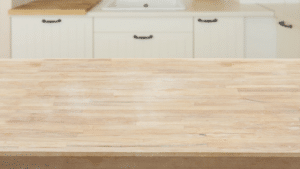When designing or remodeling a kitchen, people often focus on color schemes, cabinetry, and finishes. One important detail that impacts how your kitchen looks and functions is countertop depth. Whether you’re working with a tight layout or considering budget kitchen countertops, getting the dimensions right gives you a seamless, practical setup.
Knowing the standard kitchen counter depth helps you plan smarter, from workspace efficiency to appliance fit. This guide walks you through what’s typical, what to consider customizing, and how depth choices influence your kitchen design.
Standard kitchen countertop depth
The standard kitchen counter depth is typically 24 inches. This depth aligns perfectly with base cabinets — also 24 inches — and most kitchen appliances, allowing enough room for food prep without extending too far into your kitchen space. With a finished countertop, the total depth usually ends up around 25 to 25.5 inches, including a slight overhang at the front edge.
This measurement works well for most homeowners because it provides a balanced amount of usable space while keeping everything within reach. Wall cabinets and backsplashes also have this standard measurement in mind, helping everything fit together cleanly.
Sticking with this depth keeps the layout streamlined and functional unless you have unique design needs to consider.

Depth for kitchen islands and peninsulas
While standard counters hover around 24 inches deep, kitchen islands and peninsulas offer more flexibility. Many islands range between 36 to 48 inches deep, especially when accommodating seating, storage, or appliances on both sides. This depth supports comfortable overhangs — typically 12 to 18 inches — for barstool seating, giving you extra dining or prep space.
It’s important to consider more than depth here. The countertop kitchen height should remain consistent with the rest of the space, usually around 36 inches for standard counters and 42 inches for bar-height surfaces. Maintaining consistency in both depth and height helps create a cohesive, ergonomic kitchen layout.
Deeper countertops also impact your kitchen’s storage potential. Extending depth slightly, especially on islands or along empty walls, gives you space for extra-deep drawers or larger base cabinets.
This creates more room for items like baking trays, stock pots, or small appliances that don’t fit easily in standard-depth cabinetry. When planned well, even budget kitchen countertops help you gain square footage and storage without reconfiguring the entire layout.
How countertop depth affects function
The depth of your countertop impacts how well your kitchen works. A surface that’s too shallow may not give you enough room for meal prep, especially if appliances or decorative backsplashes take up space. Go too deep, and you’ll strain to reach items at the back or lose accessibility altogether.
That’s why sticking to a standard kitchen counter depth keeps things practical. It ensures that everything — from chopping vegetables to placing appliances — feels natural and efficient. When your layout follows ergonomic principles, even budget kitchen countertops feel well-designed to work with you, not against you.

Custom countertop depth
While standard dimensions work for most homes, there are times when custom depths make sense. Narrow galley kitchens may benefit from shallower countertops for better walkway clearance. Deeper countertops are helpful if you use large appliances, need extra prep space, or want to install a flush-mounted cooktop or sink.
Custom depths also offer more flexibility with materials and edge styles. Whether you’re working with stone slabs or composite materials, you can design around the exact dimensions of your space. That’s where professionals like Mountain States Kitchen and Bath will help tailor even budget kitchen countertops to look custom, without the premium price tag.
Depth considerations for different countertop materials
The type of material you choose may influence the decision on the depth. For example, laminate and solid surface options are often pre-cut to standard kitchen counter depth, making them a great choice for simple layouts. Natural materials like granite or quartz may require more customization, especially if you plan to extend or reinforce the surface.
Thicker materials also affect the overall countertop kitchen height, which needs to be factored into cabinet and appliance installation. If your countertop is unusually thick or includes layered edge designs, it could raise the working surface beyond the typical 36-inch height, making it uncomfortable over time.
Choosing the right depth is about fitting the space and ensuring that the material, function, and form work together.
Common mistakes to avoid with countertop depth
One of the most frequent kitchen design mistakes is assuming all countertops should be the same depth.
While the standard kitchen counter depth is reliable, applying it to an island without considering seating needs could leave you with cramped legroom or awkward overhangs. Likewise, making your countertop too deep reduces accessibility, especially for those with limited mobility.
Another common misstep is ignoring how depth affects cabinet fit and appliance integration. If you choose thicker materials for your budget kitchen countertops, the depth could impact drawer clearances or backsplash alignment. Always factor in the full build-up of your surface, including any edge treatments or substrate.
Finally, don’t forget how countertop depth and thickness influence countertop kitchen height. If your surface is too tall, daily tasks like chopping or kneading dough become uncomfortable. Measurements should always balance function with form. Houzz goes through many common kitchen measurements.

Get tailored countertops with Mountain States Kitchen and Bath
At Mountain States Kitchen and Bath, we go beyond surface-level upgrades. We help homeowners create kitchens that feel right in every detail, including countertop depth. Whether you’re sticking with the standard kitchen counter depth or need a custom layout to fit your lifestyle, our team ensures your space looks great and works even better.Our experts will walk you through material choices, sizing recommendations, and layout plans that match your needs and budget. We even offer solutions that help budget kitchen countertops feel elevated, functional, and unique. If you’re ready to explore options that balance beauty and practicality, contact us for a quote and get your dream kitchen countertops.

